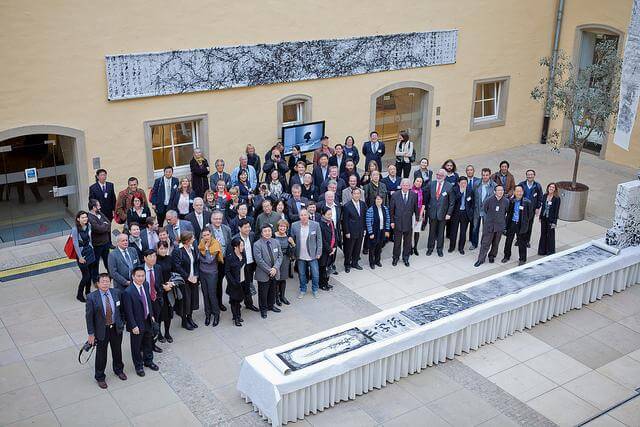
The European-Chinese Cultural Dialogue, which took place in Bucharest between 15-17 October 2014, was a success. This is what the participants of the sixth edition concluded, following three intense days of events. The dialogue, which is organized on an annual basis by EUNIC in collaboration with the Chinese Academy of Arts, was coordinated this year by the Romanian Cultural Institute.
The theme of the 6th European-Chinese Cultural Dialogue, “Public Spaces – EU and China Sharing Perspectives”, is of particular contemporary relevance due to the world’s process of rapid urbanization. The outlook of future cities represents a major challenge for both Europeans and the Chinese.
The participants amounted to over one hundred architects, artists, and decision-makers in cultural policies from Europe and China. They discussed the possibilities of artists making public spaces more dynamic by endowing them with novel values and meanings, and by involving citizens. Other issues that stood out during the proceedings featured: the economic, cultural and social weight of such participatory attitudes towards public spaces; the creation of sustainable cities; creative images and visions about future urban spaces.
“Your presence here, in Bucharest, convinced me that everything is possible when multiple determined inclinations converge, as they are driven by the most generous of intentions,” declared Lilian Zamfiroiu, the President of the Romanian Cultural Institute, the host of the event.
“Nowadays, 70 percent of China’s population lives in cities, thus facing an array of problems typical of such environments: traffic, pollution, etc. These issues must be solved,” said professor Don Ya from Tianjin University. He also made a remark on Bucharest having many buildings similar to those from China in the 1950s, the so-called matchbox-type apartment buildings. “I am not sure if available solutions are similar in Europe and China, but we discovered that many of the problems are,” noticed Liviu Jicman, the vice-president of the Romanian Cultural Institute.
Moreover, Mary McCarthy, the event’s curator and director of the National Sculpture Factory in Cork (Ireland), underlined at the end of the three days that “the dialogue among artists is different from that of politicians. It often is more efficient. In Bucharest, we pursued genuine and open interactions, which triggered numerous ideas.”
The organizers of the event emphasized that one of the most important accomplishments of the 6th edition of the European-Chinese Cultural Dialogue, was the program of residencies in the European cities of Vienna, Linz, Berlin, Stockholm, Bruxelles, and Cork. During one month, seven artists from China and Hong Kong experienced new creative opportunities and shared, in Bucharest, their findings. One of them, architect Bu Bing from Shanghai told the story of Strömbrom, a bridge in Stockholm that has pillars at varying elevations. “It is a fitting metaphor for our dialogue: two different cultures that raise a bridge between them,” concluded Mary McCarthy.
For Romania, the European-Chinese Cultural Dialogue held particular significance from one point of view: in 2014 we celebrate sixty-five years of Romanian-Chinese diplomatic relations. “It is an anniversary very dear to us. Even though Romania and China are situated at opposite corners of the globe, the two countries long established the best of bilateral relations, which is most obvious in the organization of this event and in the founding of the Romanian Cultural Institute in Beijing. The latter aims to become an interface between Romanian and Chinese cultures,” declared Lilian Zamfiroiu.
The European-Chinese Cultural Dialogue originated in a very simple idea: the creation of a framework for the two worlds to come together, to showcase the best of both cultures, and to share and search together for solutions to the challenges of our times.
See here the trilingual brochure of the event.



